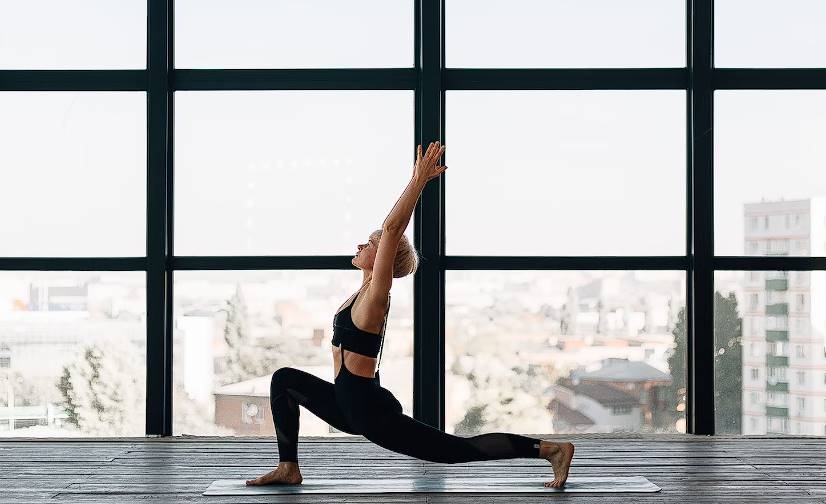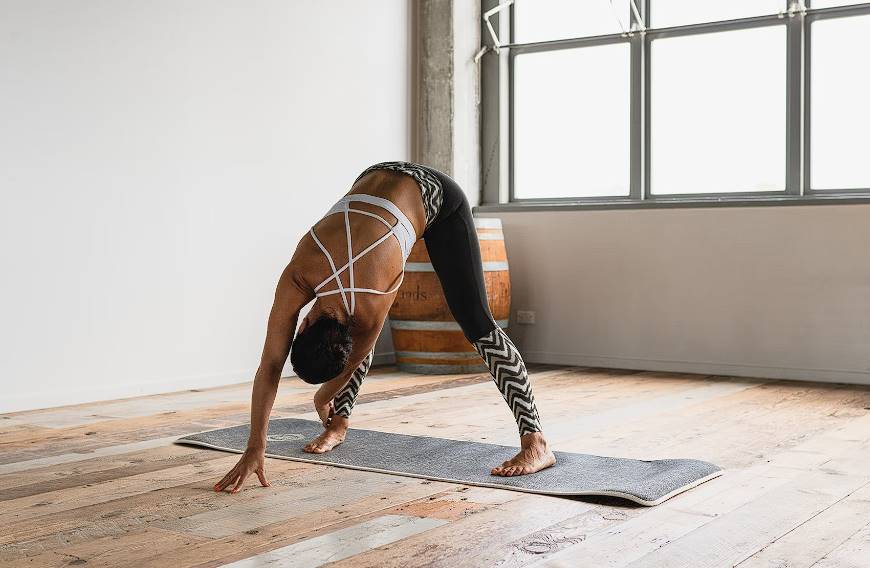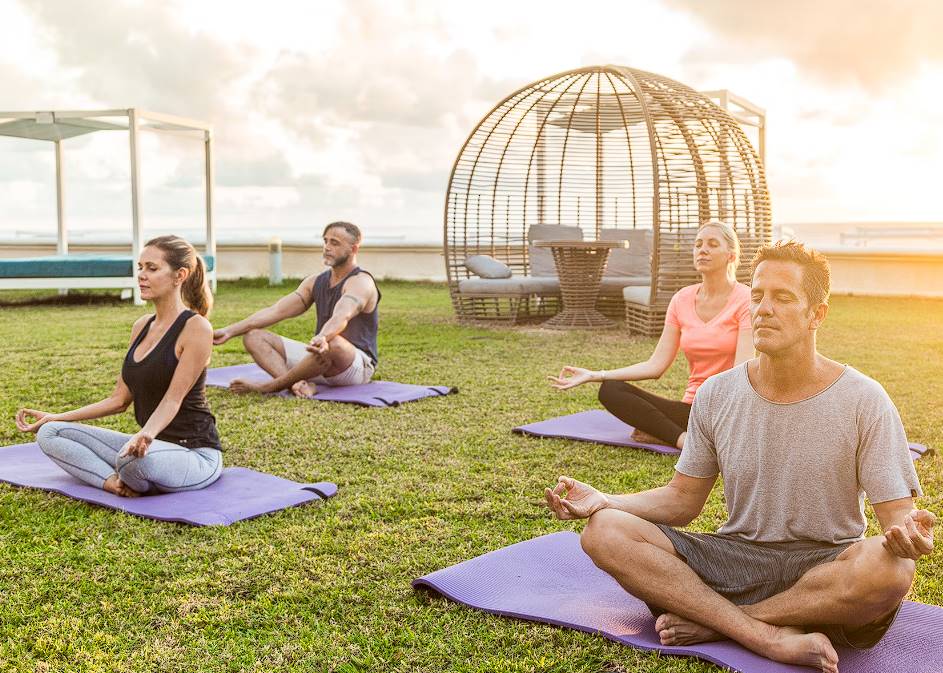Hot yoga, often known as Bikram yoga, is a rigorous exercise that has recently gained much popularity. The activity, which incorporates yoga postures and pranayama breathing techniques, takes place in a heated studio at around 40 degrees Celsius temperatures. This type of yoga attempts to simulate hot, humid conditions, and classes often last 90 minutes, during which time both students and instructors work up a good sweat.
Hot yoga poses mental obstacles besides the physical demands on the body. It raises your heart rate and causes you to sweat heavily, creating an intense physical sensation. Dehydration and lightheadedness are risks of doing hot yoga for the first time, especially if you don’t bring enough water to class. The prevalent notion that hot yoga promotes physical and mental wellness explains its broad popularity.
However, it can be unpleasant, such as when sweat runs into your eyes while doing a headstand and exhausting due to the frequent repetition of challenging dynamic sequences. Classes can be taxing because of the high temperatures, difficulty maintaining balance, and the number of lunges required. Is there any benefit to holding these positions even though you’re sweating profusely? The scientific evidence suggests that.
What Is Hot Yoga?
There is a subtle distinction between “hot yoga” and “Bikram yoga,” despite the fact that both terms are commonly used interchangeably. Developed by Bikram Choudhury, “Bikram Yoga” is done in a room heated to 105 degrees Fahrenheit (41 degrees Celsius) and humidified to 40%.
There is a set sequence for performing the 26 postures and two breathing exercises. The average duration of a Bikram yoga class is 90 minutes.
Hot yoga necessitates a slightly warmer-than-average room temperature. The ideal range for temperature during a yoga class is between 27 and 38 degrees Celsius (80 and 100 Fahrenheit). Class lengths and the types of postures practised in hot yoga sessions are both subject to change from one yoga studio to the next. In contrast to the more solemn Bikram yoga sessions, hot yoga classes typically feature music and increased student participation.
In light of the assault claims against its founder, Bikram yoga has declined in popularity recently. Rather than “Bikram yoga,” the term “hot yoga” may denote classes held in heated studios by some schools. Consequently, prospective students should give class descriptions great consideration before enrolling.

Where Hot Yoga Originated
Some background on the past is in order before we go into the evidence. In the early 1970s, Bikram Choudhury invented the original hot yoga practice, which became known as “Bikram yoga” after its founder. It consists of holding a succession of 26 static positions for 90 minutes in extremely hot conditions.
Many yoga studios have rebranded their 26-posture vinyasa sessions as “hot yoga” in recent years, emphasising instead a more fluid, personalised practice set to music (which is absent from Bikram classes).
Not everyone in the yoga world supports the idea of hot yoga. This is because sun salutations, a series of poses central to traditional yoga practice, are best done first thing in the morning before the day’s heat sets in.
What Are The Advantages Of Doing Hot Yoga?
Both hot yoga and Bikram yoga, which are practised in much hotter rooms, have the same goals of mental and physical fitness improvement and relaxation. If you hope to progress in one of the areas listed below, practising yoga in a warm setting might be worthwhile, even though it can make the practice more difficult. The following are some of the advantages that can be gained from safely practising hot yoga:
Enhances Flexibility
It’s common knowledge that stretching warmed muscles is far safer than stretching cold ones.
Therefore, a heated space like a yoga studio can facilitate greater ease and more fruitful practice of yoga postures. You’ll be able to stretch further in the warm environment, increasing your flexibility.
According to a study on the effects of 8 weeks of Bikram yoga on participants’ lower back, shoulder, and hamstring flexibility, the yoga group outperformed the control group.
Increases Calorie Burning
Approximately 183 calories per hour can be burned by a 160-pound person who practises classical yoga. More fat can be burned if the intensity is raised. A 90-minute Bikram yoga session can burn as many as 460 calories for men and 330 calories for women. If you want to burn more calories than you would during a regular yoga practice, try doing some hot yoga instead.
Weight Loss Through Hot Yoga
However, Bikram yoga has no health risks. The truth is that many people practise Bikram, and it’s different from the vast majority who have problems. Hot yoga was less strenuous than other forms of yoga. The body can endure mild exertion at a high temperature, but not vigorous sports like football.
Meanwhile, one of hot yoga’s biggest draws is the number of calories it burns. This is why hot yoga has become so popular. This is just a marketing gimmick. Studies show that hot yoga burns roughly 500 calories in a 90-minute practice, about half of what some advocates and fitness apps claim. A study found that the benefits of Bikram yoga come from the stretching and poses, not the hot environment.
Strengthens Bone Density
Bone mass can be increased with the help of certain yoga poses that require the person to carry their own weight. This is especially important because bone density naturally decreases with age, making it a very important thing to think about for older people and women who are getting close to menopause.
One study showed what a good effect Bikram yoga has on bone health. There was a noticeable increase in bone density in the neck, hips, and lower back of a group of women before menopause who did Bikram yoga daily over the course of five years. Based on what they saw, the people doing the study came up with the idea that regular Bikram yoga practise might be a way for women to lower their risk of getting osteoporosis.
Mitigates Stress
To alleviate stress healthily, many people practise yoga. Hot yoga programme considerably lowered stress levels in a group of anxious, physically inactive adults, according to a reliable source. Self-efficacy (the conviction that one can influence one’s behaviour and surroundings) and health-related quality of life were enhanced.
Combating Depression
The calming and upbeat effects of yoga are well-known. The Psychological Association suggests it may be useful as a therapy for alleviating depressive symptoms. In addition, 23 separate research examining yoga’s efficacy in treating depression determined that it is indeed helpful in alleviating depressive symptoms.
Increases Cardiovascular Performance
Performing a series of yoga postures in extreme heat might be more taxing on the body than performing the same sequence in a more comfortable environment. According to a study, a hot yoga session increases heart rate, similar to a brisk walk (3.5 mph). Both your breathing and metabolism will get a boost from doing hot yoga.
Lowers Blood Sugar Levels
Hot yoga may be an especially useful tool for persons at higher risk for type 2 diabetes. However, any form of exercise can help burn energy and reduce circulating glucose (sugar) levels in the bloodstream. Reports from researchers showed that older persons with obesity benefited more from a brief Bikram yoga programme than younger, healthier adults.
Benefits The Skin
Hot yoga aims to make you sweat a lot because that’s one of its main benefits. Sweating in a hot climate is beneficial because it increases blood flow, which carries oxygen- and nutrient-rich blood to the skin’s cells. This may aid in providing inside nourishment for your skin.
The Best Hot Yoga Techniques
Remember To Hydrate Before And After.
It stands to reason that practising hot yoga would cause one to lose fluids. Water consumption before and after class can help alleviate this problem. Get some food in you before class. Try to eat a light breakfast, even if your lesson is in the wee hours of the morning. Try to have a large lunch at least an hour before class begins, and earlier if possible (between two and three hours).
Take A Child’s Pose Or Leave The Room If You Feel Dizzy.
Lightheadedness is a common side effect of hot yoga. If you feel dizzy, lie in the child’s pose (arms out, head on the mat, and legs tucked below) or get some fresh air. Your studio may have specific policies regarding students leaving during class, so be sure to enquire about this in advance. Be wary of sudden stance changes in hot environments, as this is a common source of discomfort for first-year students.
Bring A Face Towel With You.
Sweat will almost certainly run down your face and onto your mat and may even make its way into your eyes. Bring a washcloth or tiny towel along with your water bottle. Towels are provided at some studios before each class.
Use A Towel Or A Sticky Yoga As Your Mat.
The finest yoga mats for hot yoga won’t restrict your movement but still keep you stable. For hot yoga, in particular, a long-lasting mat with good traction is essential. In addition to your trusty mat, you should also bring a towel to lay over it so that you don’t slide and fall due to sweat.
Wear Shorts Or Fitting Clothing That Is As Breathable As Possible.
This may be obvious advice, but you will be glad you followed it. Wear anything that allows free movement while also keeping you cool.
Observe Your Breathing
Keep breathing normally if you have any increased heart rate during your training. This can happen if you’re working out in extreme temperatures. Feeling your heart rate increase? Pause for a moment and relax. You can leave the room for time to gather your composure before returning.
Eventually, Your Body Will Adjust To The Heat.
Keep at it, as yoga masters will all tell you; it will get easier with time. Your body will adapt to the heat in the same way that it adapts to new yoga poses. Keep going if you find dealing with the heat difficult initially.

Consider Your Alternatives.
Not every steamy studio, indeed, is the same. You can’t expect to learn the same techniques or get the same instruction at every studio. It is possible that certain studios are called “hot” because they only provide “hot” classes. Some studios provide heated courses, as well as others that do not.
Remember that hot yoga studios will use a different (and more efficient) heating and ventilation system than other studios. The temperature and the heat level vary from one studio to the next.
Maintain Your Own Pace.
This is the single most crucial piece of advice for hot yoga. You do not need to hold each stance simultaneously as everyone else. If you start to feel disoriented, try returning your attention to your breathing. Blocks can assist you in achieving poses that require greater flexibility than you currently possess.
Pay Attention To Your Body.
Remember that you are the finest teacher of yourself and your body. To help you get set up and offer advice and best practices, your teacher will appreciate knowing in advance that you are new to the course. Avoiding studios that forbid basic comforts like water and bathroom breaks.
Safety Advice
Hot yoga poses are safe for those who are otherwise healthy. However, it’s important to take some precautions like any form of physical activity.
- Hot yoga poses serious health risks, especially dehydration. You must stay hydrated before, during, and after a hot yoga session. You may need to replenish electrolytes lost during your hot yoga practice, and a low-calorie sports drink can do just that.
- Some people are more vulnerable to heat stroke than others due to preexisting health issues. Heart disease, diabetes, anorexia nervosa, vascular irregularities, and a history of fainting are all examples of such conditions.
- Hot yoga can cause dizziness or lightheadedness in those with low blood pressure or blood sugar. Before beginning a hot yoga practice, it’s important to clear it with your physician.
- Women expecting a child should check with their physicians before participating in hot yoga.
- You may want to avoid hot yoga if you’ve ever experienced symptoms of heat intolerance.
- If you start to feel faint or queasy, you should stop immediately. Get out of here and take a nap somewhere cooler.
Conclusion
Hot yoga, also called Bikram yoga, is a popular form of exercise that combines yoga poses and breathing methods called pranayama in a studio heated to about 40 degrees Celsius. It lasts 90 minutes and is meant to mimic hot, humid weather. Both students and instructors sweat a lot during this time. Hot yoga is famous because it can be good for your body and mind, but it can also be uncomfortable because you sweat and get tired. Bikram Choudhury came up with Bikram yoga. It is done in a room that is 105 degrees Fahrenheit and 40% humid. Between 27 and 38 degrees Celsius is the best temperature range for a yoga class.
Bikram yoga is more solemn and quiet, while hot yoga classes usually have music and more student involvement. Bikram Choudhury created the first hot yoga practice in the early 1970s. This was when hot yoga got its start. It includes staying still in 26 different positions for 90 minutes in very hot weather. In the past few years, many yoga schools have started calling their 26-posture vinyasa sessions “hot yoga,” emphasising a more fluid, individualised practice set to music.
Some of the benefits of hot yoga are that it makes you more flexible and burns more calories than stretching cold muscles. Men can burn up to 460 calories in 90 minutes of Bikram yoga, while women can burn up to 330 calories. But some people may not like the pain caused by sweat.
Hot yoga is a famous type of yoga that has been shown to be good for your health in many ways, such as helping you lose weight, keep your bones healthy, relieve stress and depression, improve your heart health, and lower your blood sugar levels. It’s not as hard as other types of yoga, and the body can handle light effort at high temperatures. But a 90-minute session of hot yoga burns about 500 calories, which is about half of what some advocates and exercise apps say. Studies have shown that hot yoga can also improve bone health, which is very important for older people and women getting close to menopause.
Hot yoga can also help you feel calm, and some studies show that it may be helpful for treating sadness. It also makes your heart work harder, which can be harder on your body than doing the same routine in a more comfortable place. Also, hot yoga can lower blood sugar, which makes it a great tool for people who are more likely to get type 2 diabetes.
To enjoy hot yoga, it’s important to remember to drink water before and after class, eat before class, and stay away from the child’s pose or the room if you feel dizzy.
To get ready for hot yoga, you need to follow the rules and bring a face towel, a towel, or a yoga mat that is sticky. Wear shorts or other clothes that let air in to stay cool and comfortable. Watch how you breathe and slow down and relax if you feel your heart rate going up because of the heat.
Different studios may have different ways to heat and cool the space, so think about your choices before picking a studio. Pay attention to your body and go at your own pace. Hot yoga poses are safe for healthy people, but precautions should be taken as with any other physical practice. Dehydration is dangerous to your health, so it’s important to drink water before, during, and after a workout. Heart disease, diabetes, anorexia nervosa, arterial problems, and fainting can all make it more likely that someone will get heat stroke.
If you have low blood sugar or blood pressure, hot yoga can make you feel dizzy or faint. Talk to a doctor before starting hot yoga, and women who are having a baby should also talk to their doctor before taking part. If you can’t handle the heat, don’t do hot yoga and take a nap instead.
Content Summary
- Hot yoga, known as Bikram yoga, has gained immense popularity recently, incorporating yoga postures in a heated environment.
- This form of yoga is performed at 40 degrees Celsius, simulating hot and humid conditions, with classes often lasting 90 minutes.
- Hot yoga provides both mental challenges and physical demands, increasing the heart rate and causing intense sweating.
- Dehydration and lightheadedness can be risks, particularly for newcomers who may not bring enough water.
- Despite its challenges, hot yoga is popular for promoting physical and mental wellness.
- In Bikram yoga, a sequence of 26 postures and two breathing exercises is performed in a room heated to 41 degrees Celsius.
- Unlike Bikram yoga, hot yoga classes often feature music and can have varying temperatures, lengths, and postures.
- The term “hot yoga” has increasingly been used to describe classes in heated studios following assault allegations against Bikram Choudhury.
- Bikram yoga originated in the early 1970s by Bikram Choudhury and included holding 26 static positions.
- Some yoga studios have rebranded their sessions as “hot yoga” for a more fluid practice, often set to music.
- Traditional yoga advocates may oppose hot yoga, as sun salutations are traditionally done before the day’s heat sets in.
- Hot and Bikram yoga aims to improve mental and physical fitness and relaxation.
- Practising in a warm setting can enhance flexibility by allowing a greater stretch.
- A study revealed Bikram yoga improved participants’ flexibility in the lower back, shoulder, and hamstring.
- Practising hot yoga may increase calorie burning, with men potentially burning 460 calories and women 330 calories in a 90-minute session.
- Hot yoga has been associated with weight loss but is found to be less strenuous than other forms.
- Contrary to some marketing claims, hot yoga burns roughly 500 calories in a 90-minute practice.
- Certain yoga poses can strengthen bone density, which is vital for older individuals and women approaching menopause.
- A five-year study on women showed an increase in bone density through daily Bikram yoga practice.
- Hot yoga can mitigate stress, and one study found it considerably lowered stress levels in anxious, inactive adults.
- Yoga, including hot yoga, can be beneficial in combating depression, providing calming effects.
- Hot yoga can increase cardiovascular performance, akin to a brisk walk, boosting breathing and metabolism.
- For those at risk for type 2 diabetes, hot yoga can help reduce glucose levels.
- The practice may also benefit the skin by increasing blood flow through sweating, providing nourishment.
- Hydration before and after a hot yoga class is essential to counter fluid loss.
- If lightheadedness occurs, it is advised to take a child’s pose or leave the room.
- A face towel may be necessary to handle sweat during practice.
- Using a towel or sticky yoga mat helps maintain stability, preventing slipping due to sweat.
- Breathable and fitting clothing is recommended for free movement and keeping cool.
- Observing breathing is essential, particularly if the heart rate increases during practice.
- With time, the body can adjust to the heat, making the practice more comfortable.
- It is essential to consider the variety of hot yoga studios and techniques, as temperature and instruction may vary.
- Maintaining one’s own pace and listening to the body is vital for a successful practice.
- Safety is paramount, and hot yoga is generally safe for healthy individuals with proper precautions.
- Dehydration is a serious risk, so hydration with water or low-calorie sports drinks is crucial.
- People with certain health conditions like heart disease or diabetes may be more vulnerable to heat stroke and should take extra care.
- Pregnant women should consult their physicians before engaging in hot yoga.
- Individuals with heat intolerance symptoms may wish to avoid this practice.
- Immediate cessation and rest in a cooler place are advised if one starts to feel faint or nauseous.
- Hot yoga may also be referred to by different names or techniques across various studios.
- There’s a difference between “hot yoga” and “Bikram yoga,” with Bikram having a set sequence and stricter conditions.
- Many studios now prefer to offer hot yoga due to Bikram yoga’s decline in popularity over controversies.
- Hot yoga aims for a slightly warmer-than-average room temperature, typically ranging between 27 and 38 degrees Celsius.
- Some view hot yoga as a marketing gimmick, but studies do show benefits from the stretching and poses.
- Hot yoga encourages more student participation compared to Bikram yoga and often includes music.
- Hot yoga practices aim for increased calorie burning and fat loss but with fewer strenuous demands.
- The benefits of hot yoga include stress mitigation, depression alleviation, and increased bone density.
- Proper nourishment, including light meals before class, is recommended to maintain energy levels.
- Using proper mats and towels ensures stability and comfort during sweaty hot yoga sessions.
- Different studios may offer different types of hot classes, so prospective students should carefully read class descriptions.
Frequently Asked Questions
Is Hot Yoga Beneficial?
Hot yoga is a form of movement and exercise — and it can be very helpful for people trying to improve their fitness or lose weight. But she says it typically delivers more benefits in terms of relaxation, stress relief, and muscle recovery rather than calorie burning.
What Are The Proven Benefits Of Hot Yoga?
Besides the various health benefits of traditional yoga, like flexibility, enhanced muscular endurance, and de-stress, hot yoga offers an intense workout that helps burn calories, reduce blood sugar, improve skin, and more.
Is It Necessary To Sweat During Yoga?
Sweat is good in yoga, as in life. It releases impurities from the bloodstream, and it helps cool the body. But it’s not necessary.
Is Hot Yoga Enough Of A Workout?
It burns major calories. Even though you’re not running and jumping around, that hot room gets the heart going again. One study from Medicine & Science in Sports & Exercise found that women burned an average of 333 calories during a 90-minute slow-moving, heated yoga session.
Is Sweating In Hot Yoga Good For You?
Sweating, and a lot of it, is one of the main objectives of hot yoga. One of the benefits of sweating in a warm environment is that it can improve circulation, bringing oxygen- and nutrient-rich blood to skin cells. This may help to nourish your skin from the inside.

